#joibittlestudio
Explore tagged Tumblr posts
Text
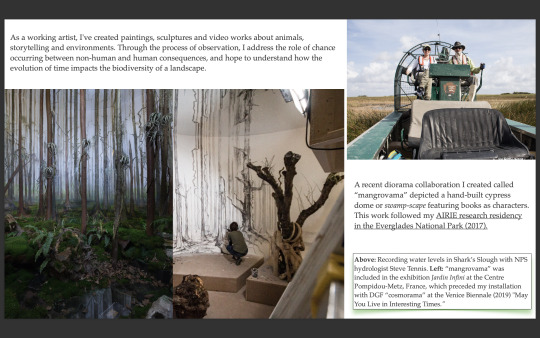
HERE: Revisiting environmental and animal sciences by rethinking the "swampscape" through the social practice and process of art-making, science research and fieldwork.
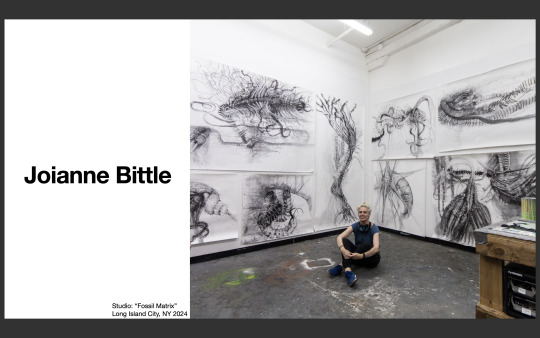

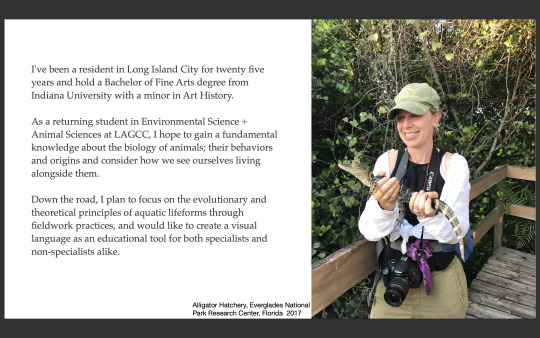
Rethinking...
Revisiting...
Reconstructing...
Thanks to LAGCC Student Ambassador's STEM program at CUNY for the invitation to present and introduce my ideas and experience to new students and the Department Chair Faculty in physical sciences + mathematics, biological + environmental science.
I'm looking forward to continuing my studies alongside this community in Long Island City!
29 Feb. 2024
#cuny#ambassador#art and science#environmental science#airieverglades#joibittlestudio#long island city#nyc
1 note
·
View note
Text




summer studio tests:
...crater chains, shell-builders, chambers, segments and various rabbit skin glue preparations for Vancouver Island, August 2023.
0 notes
Video
tumblr

robotics +
animal thought +
science lab +
art studio +
0 notes
Photo










working ideas for “The Hills Have Eyes” & “The Coming of Planktonic Lifeforms”
extremophiles (imagined) from field to studio
sketches 2022
#extremophiles#joibittlestudio#the hills have eyes#fieldwork#death valley#planktonic#joianne bittle#nyc
1 note
·
View note
Video
tumblr


Testing gravity boots and phosphorescent pigments today...
Here’s to 2022!
0 notes
Photo





NEW RELEASE for summer 2017 !
I’m thrilled to have a conversation text with Dominique Gonzalez-Foerster published by Palais de Tokyo and Flammarion Editions for their recent catalogue Dioramas Contemporains (with a selection of our images).
http://editions.flammarion.com/Catalogue/hors-collection/art/dioramas
Also, the catalogue includes a segment by my colleague and friend Stephen C. Quinn from the American Museum of Natural History as well as essays by Marcel Duchamp, Louis Daguerre and many others.
OUR CONVERSATION (English translation below) ... on the real, the non real, clock-work-time-machines, painting on walls, transformations, Ballard and the others...
DGF: The first time I saw the diorama halls at the American Museum of Natural History in New York, like many visitors, I was mesmerized by this incredible display of landscapes. They connected so directly with Duchamp's «Etant Donné», pre-cinema panoramas, and multiple other 19-century exhibition devices which had been slowly replaced by cinema and more conceptual or abstract ways to exhibit objects, informations, beings, places and stories. Thinking of exhibition as a medium that encloses all parameters – from title, to lighting, to sound, audience, and time – has always been an important part of my artistic research and practice. I have always been more interested in immersive artworks than autonomous objects and fascinated by 1:1 scale, period rooms and staged moments.
So when I was invited by Lynne Cook at Dia to imagine a project for the newly re-opened Hispanic Society (which has a fantastic library but only until early 20th-century), I thought it would be exciting to imagine a new annex with 20th-century books that would appear in a completely different way and exist in landscapes almost like living species. Instead of animals or humans, one would see books in a desertic, tropical or atlantic landscape. I really wanted the dioramas to look like the ones at the American Museum of Natural History and not a superficial interpretation so we contacted the museum and I had a first meeting with Joi Bittle.
JB: When I got the call to work with Dominique and Dia, I was just completing a background painting for an exhibition at AMNH, where I was applying the traditional painting techniques of James Perry Wilson. A senior colleague recommended me for the project, explaining to me – with some bewilderment – that it was intended to be contemporary art. Now, nearly ten years later, Dominique and I have pushed our conversation beyond traditional diorama techniques, as we explore environments, art history, architecture, film and literature. So far, we have created three deserts, one jungle, one swamp, an underwater scene and a tree top canopy, all site-specific and human size.
Both in the field and during the painting process itself, I'm hungry for knowledge and for pushing physical limits. With that, science fiction stories and our talks about supernatural- strange things have become essential to visualizing these landscapes with Dominique. An important part of then constructing the diorama for me is to physically enter the actual landscape, and then, I stay a while. I create a private “mapping” of geologic history, personal explorations in the field, observations of animal life, and scientific studies of ecology. I'm interested in how time, humans and non-humans have impacted a place.
In the end, though, our dioramas are not illustrations of a landscape for the purpose of education as they are in the context of a natural history museum.
DGF: The process to elaborate these «landscapes with books», or places somehow containing their own bibliography, mainly novels but also some essays specially in the new «Mangrovama» is a long one. The first step is to define the landscape, which emerges as a combination of visions, places and typologies that I have in mind combined with Joi’s own investigations and research on different real sites/fields.
So each landscape contains a very precise, dense and real amount of geology and plants, but also a lot of thinking about time, like when is this landscape happening on a longer timeline? But also at which hour of the day are we encountering this moment? The shadows play an important part... Time becomes an interesting question, too, in relation to the time necessary to elaborate the landscapes in advance, and then to make them exist on site. They require several weeks to install, far beyond the usual amount of time planned for an exhibition installation, which forces museum schedules to adapt. It almost seems then that the realization of the diorama becomes like a clock for the rest of the exhibition.
From the construction of the curved walls until the closing of the window(s), and the separation but also conservation of the landscape, there is a long and impressive sequence of moments that become invisible to the viewer but give a presence and a density that would
be impossible to obtain otherwise.
JB: Yes, people often react with surprise when they learn the diorama is built on-site up to the opening of the exhibition, like a clockwork-time-machine of sorts! Our dioramas are a kind of speculation, assembled from fragments of what was, what is, and what could be. They evolve by being worked on, like pieces of a jigsaw puzzle. But it's a puzzle without a key to tell us how it should look in the end, and we have to discover that. This part is very exciting, as the surroundings of the curved-walls demand a focused discovery of the difference between the literal and illusionistic spaces. Then, the physical movement of the body must navigate that difference and guide the painting process for me each day.
Since I was once a student of the traditional techniques, I can now develop 2-D with 3-D and derail from the rules. The first step is to create an illusion of deep space on a blank white wall, with only a piece of charcoal, a ladder and a calendar of days pinned up nearby. The horizon line grid, a color temperature and a mental narrative directs the work from there, while we always remain open to chance.
For humans, the appeal of a diorama is its ability to deliver a sense of wonder in multiple dimensions, by transporting us somewhere else, by tapping into our own “reality” and presenting a virtual biodiversity for our senses. With this comes the problem of setting a piece of the natural world into architecture and making the non-real, real, or maybe that's the other way around?
DGF: Since an exhibition is also a kind of philosophical device to increase consciousness and awareness in our relation to art, narrative, existence, space and time, it's deeply interesting to explore this tension between what is existing inside and outside, what feels artificial or real, what is represented, imported, staged and how we react to that. How much we accept to be affected by what we see or feel and what kind of memories it produces. I have never been so much into autonomous objects and artworks because I’m totally fascinated by the limits (existing, invisible or not) rather than the center.
The blurred zone which exists between life-size environments/installations like dioramas, rooms or other type of spaces and the rest of the exhibition/context is a zone to research. The spatial and visual paratext composed by the full exhibition, the exhibition space, the city, the landscape around and even the audience is an important dimension which is somehow redefined, «transplaced» and channeled in an incredible way by the diorama. There is a kind of magic mirror situation of two spaces looking at each other. The books – inside the landscape – act for the viewers like in the beautiful Fahrenheit 451 scene in Francois Truffaut’s film in which humans have to become living books in the forest in order to keep literature alive – or the way people become/are called books like in the 1973 film Soylent Green. One of the books appearing underwater in the «Mangrovama» swamp is a graphic novel by Richard McGuire which beautifully shows the superposition and stratification of different moments/periods/situation in one place.
With Joi and J.G. Ballard I learned a lot about all the different landscapes contained in one and how going through these landscapes can transform us and affect our psychogeography. Sometime we can even identify completely with a landscape or a biotope like in the «Swamp Thing».
JB: The creature swamp thing was a blessing in disguise for us and began emerging under our skin together! We started talking about it when building Desertic the year before. His curious obsession of seeking through chemistry and environment end up accidentally transforming and revealing the invisible self.
Working with Dominique awakens this spirit! Quickly, we cross reference these connections, taking us into a garden of forking paths.
Artists and scientists together have the chance to push the boundaries, or ignore them completely. As an artist, this setting continues to help me learn and unlearn all the time. As with Ballard, the fundamental principles of science run deep through his vision, and this no doubt has led him into a mix of both logical and invented worlds, producing a knowledge through story telling.
Consider Mangrovama – a synthetic carpet is laid down outside the interior of the diorama. During construction, I know the carpet will be placed there in the end, but it has no significance for me in the moment. However, for us, this is not unlike getting a fossil mold or light fixture to fit just right, thus making the landscape a single unit.
Split by glass, the real moss sculpted by hand and the moss-like carpet evoke a strange reoccurring memory for me. The space brings me to my childhood bedroom where I made drawings and played with plastic dinosaurs on a comfortable floor, imagining far off worlds to come. Here, the real and non-real elements together in our dioramas aid in a deeper sense of dreaming, and these dreams could be our most important guides to another new reality.
DGF: As one diorama leads to the next, and while we were processing «Mangrovama»,I was also reading Leigh Brackett’s beautiful romantic description of planet Mars, which, like Hubert Robert’s paintings, integrates a fantastic sense of ruins and gone ancient cultures. Mixed with the present, with nature and desert, an idea also appears in Ray Bradbury’s Martian Chronicles strongly critical of the human way to colonize new landscapes and planets without any questions or doubts about possible destructions – and definitive loss – of other possibilities. The new dream/diorama might be about another planet and about these questions. We have now collaborated for almost 10 years and I hope there is a lot more to come until 2058 ...
Dominique Gonzalez-Foerster
Joianne Bittle
2017
#dioramas#palaisdetokyo#joibittlestudio#joiannebittle#dominique gonzalez foerster#mangrovama#centre pompidou#painting#sculpture#art#nature#science#museums#science fiction
4 notes
·
View notes
Video
vimeo
“Occurrence at the Crawdad Pond”
2012-2017
HD video with soundtrack by Command X, an assist from two robot voices and Milton’s Paradise Lost.
“...I left the pond and returned to Queens...from the mythology of origins (a garden of paradise) to techno-utopian deliverance (a post-biological subject), the whole schmear comes and goes in, like, a long weekend. In the end, it’s really quite an open question whether a crayfish has a mind or not.”
Joianne Bittle
excerpt from The Rib / User’s Manual
2 notes
·
View notes
Photo





Studio days, winter 2018, Long Island City, Queens
In the works, a series of 5 new paintings called Mutatis-Mutandis; thinking of camp lonesome, prismatic landscapes, iguana suits, gene expression, tree islands, unidentified bystanders and uncertainties on Old Ingraham Highway, re-visiting photo archives and selected books with new writings.
And, a lot of school studying! with another completed evolution course this term - biological adaptation, isolation and speciation in environments.
Springtime news here: http://joibittle.tumblr.com/
0 notes
Photo
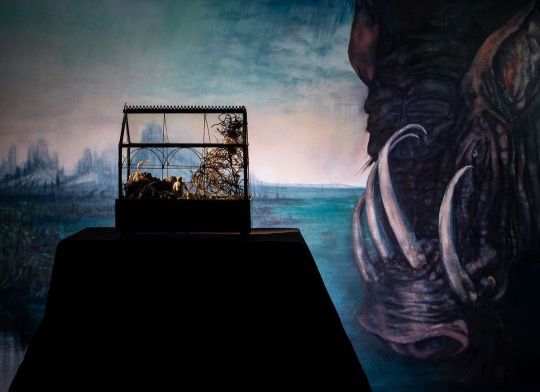


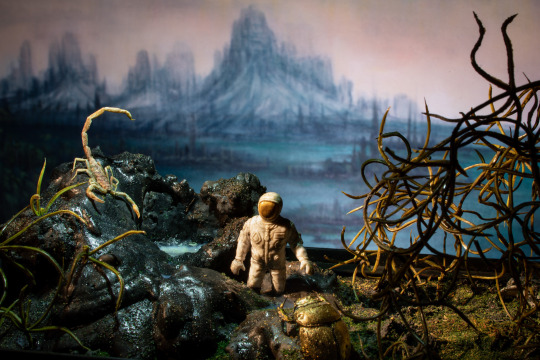
HNY from the studio! Here’s to keeping the doors open, terrariums, emerging seedlings, peace and truths… #2022 🌱 • • • #phosphorescence #scorpion #dungbeetle #moonman #pyroclastic #swampscape #seedlings #barbirusapig #painting #truths #terrarium #covarium #reset #mutatismutandis @joibittlestudio 🌱🪲🦂🐗🌋 🛶🌐❤️🩹 (at Queens, New York) https://www.instagram.com/p/CYJubtJrkmh/?utm_medium=tumblr
#2022#phosphorescence#scorpion#dungbeetle#moonman#pyroclastic#swampscape#seedlings#barbirusapig#painting#truths#terrarium#covarium#reset#mutatismutandis
0 notes
Photo




Here: Storyboards and architectural blueprints for my next diorama landscape, MARS.
I’m looking forward to making this human-scale work in Leipzig, Germany this fall as part of DGF’s exhibition Exotourisme, 2018.
It’s great to be working on a Mars landscape in the present (especially after recently completing an intense physics course about dark energy this summer!)
Now, with new discoveries of liquid water beneath ice caps on Mars and ancient Siberian worms being resurrected after 40,000 years, I’m diving back into previous ideas of microbial lifeforms, radiation levels, fossilized landscapes, crater impacts, deep time and the human condition.
So, I have many questions and too much time is spent studying science and daydreaming perhaps ...but, I’ll continue to work on paintings and hope imagining these worlds will give purpose.
My first thoughts...Maybe the arc of cosmic history in our solar system does bend back to the red planet...
More NEWS here: http://joibittle.tumblr.com/
2 notes
·
View notes
Video
vimeo
The 2017-2018 school year at SVA has come to a close. For now, I’m looking forward to a break from giving three hour lectures!
Alongside my related art projects, I was happy to design and teach these courses for the Department of Humanities and Sciences at The School of Visual Arts. Above is a brief slideshow overview of the topics.
HSD-2921-R History of Nature / Nature of History - 3 credits (Fall semester)* HSD-2898-R Warm and Cold Vertebrate Origins - 3 credits (Fall semester)* HSD-2666-R Living Planet - 3 credits (Spring semester)*
*undergraduate/graduate and open to anyone and everyone.
WE ARE ALL STARDUST!
Also, I am saddened by the loss of co-chair Robert Milgrom this year. I’m eternally grateful for the teaching opportunities he has given me the past four years. Robert supported new ideas and gave me a chance to develop and present these topics to art students in a totally different way. The best gift to give in a lifetime is the opportunity to keep learning, always.
1 note
·
View note